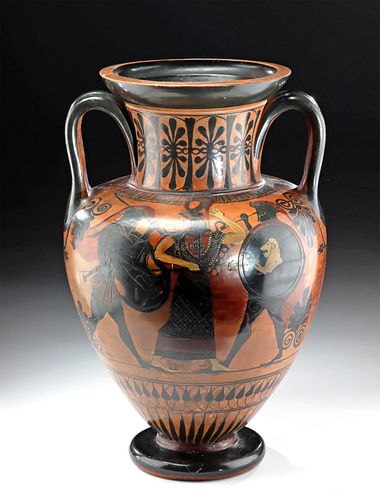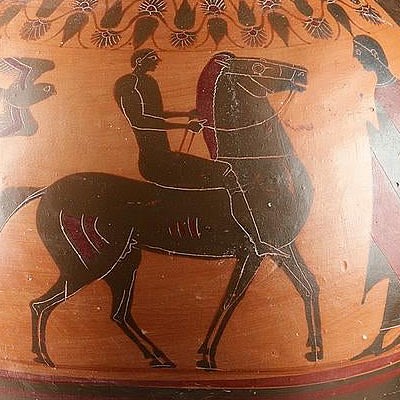Greek Attic Amphora Athena, Herakles, Oxford TL
Lot 19b
About Seller
Artemis Fine Arts
686 S Taylor Ave, Ste 106
Louisville, CO 80027
United States
Selling antiquities, ancient and ethnographic art online since 1993, Artemis Gallery specializes in Classical Antiquities (Egyptian, Greek, Roman, Near Eastern), Asian, Pre-Columbian, African / Tribal / Oceanographic art. Our extensive inventory includes pottery, stone, metal, wood, glass and textil...Read more
Categories
Estimate:
$50,000 - $75,000
Absentee vs Live bid
Two ways to bid:
- Leave a max absentee bid and the platform will bid on your behalf up to your maximum bid during the live auction.
- Bid live during the auction and your bids will be submitted real-time to the auctioneer.
Bid Increments
| Price | Bid Increment |
|---|---|
| $0 | $25 |
| $300 | $50 |
| $1,000 | $100 |
| $2,000 | $250 |
| $5,000 | $500 |
| $10,000 | $1,000 |
| $20,000 | $2,500 |
| $50,000 | $5,000 |
| $100,000 | $10,000 |
| $200,000 | $20,000 |
About Auction
By Artemis Fine Arts
Jun 4, 2020
Set Reminder
2020-06-04 10:00:00
2020-06-04 10:00:00
America/New_York
Bidsquare
Bidsquare : Exceptional Antiquities, Asian, Ethnographic
https://www.bidsquare.com/auctions/artemis-gallery/exceptional-antiquities-asian-ethnographic-5185
An important one-day auction featuring museum-worthy examples of Egyptian, Greek, Roman, Etruscan, Near Eastern, Far East / Asian, Pre-Columbian, African / Tribal, Oceanic, Native American, Spanish Colonial, Russian, Fossils, Ancient Jewelry, Fine Art, so much more! Artemis Fine Arts info@artemisgallery.com
An important one-day auction featuring museum-worthy examples of Egyptian, Greek, Roman, Etruscan, Near Eastern, Far East / Asian, Pre-Columbian, African / Tribal, Oceanic, Native American, Spanish Colonial, Russian, Fossils, Ancient Jewelry, Fine Art, so much more! Artemis Fine Arts info@artemisgallery.com
- Lot Description
Ancient Greece, Athens, Early Attic, ca. 530 to 520 BCE. A very large and incredibly fine black-figure neck amphora of an exceptionally elegant, classic form - both sides expertly painted with mesmerizing mythological scenes. Side A features Herakles wrestling either the sea-god Triton or Nereus, the latter morphing into the former. The figures are engaged in an action-packed struggle involving major physical contortions - with details incised as well as delineated in red and white pigments. Side B presents an elaborately dressed Athena standing in composite profile as an interceder between a pair of fighting warriors - perhaps Ajax and Achilles - both donning helmets and wielding spears and shields (one shield adorned by an image of a roaring lion, an animal associated with Achilles). Athena is positioned between these leading men of the Greek army holding a spear of her own between them and raising her left hand in a gesture of protest. Size: 9.6" W x 15.2" H (24.4 cm x 38.6 cm)
Interestingly, other Attic vases depict Athena between a gaming Achilles and Ajax, but these warriors, in contrast, are fighting. In this context, it is more customary to see a bearded herald as the interceder, as on a neck amphora in the Victoria and Albert Museum, which also has Herakles and Triton on the obverse.
Adding to the piece is the rich decorative program: the register of stylized palmettes adorning the neck; bands of tongue motifs just below; symmetrical floral vines below each tripartite handle; and beneath the pictorial imagery a register of fine-line, stylized laurel buds with looping stems followed by rays emerging from the base below.
Ancient Athenian painters, including the painter of this vessel, took advantage of the large size of Attic vases which gave them more room to explore their techniques, overlap figures, present complex interactions between figures, create depth and attempt renderings of perspective, as well as add other colors such as the red and white pigments on the scene of Herakles vs. the Sea God as well as Athena and the fighting soldiers.
An Attic black-figure neck amphora at the J. Paul Getty Museum features a somewhat similar scene attributed to the Leagros Group (active 525 to 500 BCE), though with the warriors sitting rather than standing. The curatorial staff writes, "This scene was very popular in Athenian vase-painting of the late 500s B.C. and was a favorite of the painters in the Leagros Group. Some scholars believe that this mythological scene also served as a contemporary political parable on the value of staying alert, since the tyrant Peisistratos had been able to take control of the city of Athens while the army was distracted."
This piece has been tested by Oxford Authentication using thermoluminescence (TL) and has been found to be ancient and of the period stated. A full report will accompany purchase.
Provenance: private East Coast, USA collection, acquired in December 2018; ex-Artemis Gallery;
All items legal to buy/sell under U.S. Statute covering cultural patrimony Code 2600, CHAPTER 14, and are guaranteed to be as described or your money back.
A Certificate of Authenticity will accompany all winning bids.
We ship worldwide and handle all shipping in-house for your convenience.
#156071Repaired from roughly 20 pieces, with small chips in some areas and both handles reattached, and resurfacing with overpainting along break lines. Abrasions and fading to several areas of pigment, several areas of touch-up paint to figures and areas of the decorative program and field, and encrustations and visible break lines within interior. One TL drill hole inside of one lower handle terminal.Condition
- Shipping Info
-
All shipping is handled in-house for your convenience. Your invoice from Artemis Gallery will include shipping calculation instructions. If in doubt, please inquire BEFORE bidding for estimated shipping costs for individual items.
-
- Buyer's Premium



 EUR
EUR CAD
CAD AUD
AUD GBP
GBP MXN
MXN HKD
HKD CNY
CNY MYR
MYR SEK
SEK SGD
SGD CHF
CHF THB
THB



















